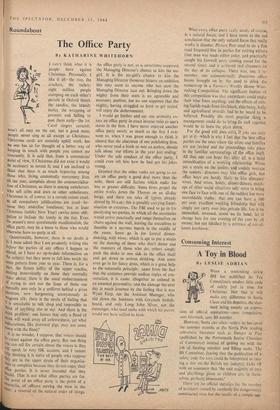Consuming Interest
A Toy in Blood
Bs LESLIE ADRIAN Willi a resounding tinkle BSI has published its Toy Committee's modest little code of safety just in time for Christmas. Not that it will make any difference to Santa Claus and his deputies, the stan- dard being merely an .expres- sion of official aspirations—sans compulsion, sans kitemark, sans BS number.
However, Santa can relax—unless he has spent the summer months at the North Pole reading subversive literature such as Danger at Play (published by the Portsmouth Junior Chamber of Commerce) instead of getting on with the job of feeding reindeer and 'filling sacks. The BS Committee, fearing that the publication of a safety code for toys could be interpreted as cast- ing a slur on the British toy industry, kicks off with an assurance that 'the vast majority of toys and playthings given to children arc, in them- selves, perfectly innocuous:
There arc no official statistics for the number of accidents pausedused by carelessly (or dangerously) constructed ioys„but the results of a sample SLIT-
vey on this subject carried out by the Junior Chamber of Commerce at Portsmouth hardly justifies the committee's complacency.
Out of the 336 children who took part in the Portsmouth survey, 138 had suffered some sort of accident at play—and only one third of these mishaps were classified by the investigators as 'trivial.' (Unfortunately the report does not give any clear definition of their three categories of injury, `trivial,' minor' and 'serious.') It was this report that brought home to BSI the urgency of establishing a safety standard for toys. The industry, predictably enough, re- acted to the Portsmouth revelations with a string of alternative defences—like an Irishman trying to wriggle out of an assault-and-battery charge CI didn't do it, my Lord, and if I did, I didn't mean to and if I did mean to it was self-defence —and, anyhow, he had it coming').
The manufacturers first dismissed the Ports- mouth report as exaggerated and alarmist—and then went on to blame the high accident rate on the poor quality of imported playthings, and on parents who lack the wisdom to choose toys appropriate to the age and intelligence of their offspring. And if any blame could be traced to a British-made toy, the bauble probably came from one of those low-life firms (outside the British Toy Manufacturers' Association) who make handouts for cereal packets or miniature junk for Christmas crackers.
In compiling their code of safety requirements, the Toy Committee comes down unequivocally on the side of the angels where such matters as lead paint, sharp edges, flammability and ex- posed clockwork motors are concerned, and it recommends the rustproofing of outdoor toys, voltage limitation for electric motors, clean, soft fillings for cuddly toys, sound fixings for swings and safety stops on any folding parts— such as the arm of the hood on a doll's pram —which could crush small fingers like nuts in a nutcracker.' -- Two fatal accidents were recorded by the random survey at Portsmouth; in both cases the child choked to death after biting off and swallowing part of a toy. Injuries of this type —all potentially fatal—accounted for more than a sixth of all the accidents investigated. Out of my own rather limited circle of infant friends, two toddlers have only been saved from asphyxi- ation by prompt and violent action by an adult who happened to be in the room at the time.
Reputable manufacturers are fully alive to the swallowing menace and do their best to guard against it. Teddy bears and their relations can be made with irremovable eyes (as Wendy Boston, Merrythought Child's Play, among others, have shown), and some manufacturers do devise systems for making the nuts and screws on large toys, as well as prams and cots, proof against the most persistent undoer.
But whatever children might manage to swallow, the subject was a bit too much for the Toy Standards Committee. It dismissed it with a passing reference to 'the risks, chiefly through swallowing and cutting, in certain toys . . . found in crackers [or] distributed as pre- mium gifts with other goods'; and a footnote postponing effective action on the problem of detachable eyes pending further consideration.
When it comes to rattles, I can only say that I'm astounded that a committee that includes representatives of the BMA should consider that 'non-poisonous seeds, smooth glass balls and small plastic pellets' are suitable clatter-makers. I suspect that even the BSI press office had doubts about this, because the press handout on the Safety Code referred only to sugar crystals, which were also included in the com- mittee's list of approved fillings for rattles.
In spite of all these strictures, I can't help welcoming the Safety Code for Toys. Eventu- ally, when the Government gets around to giving BSI a realistic budget for testing consumer goods (at present they get a grant of £10,000), this modest list of suggestions for toy-makers may become an effective and recognisable standard. In the meantime it has served the useful purpose of drawing everyone's attention to some of the hazards that lurk in the nursery toy cupboard.
`Babyminders,' of 88 George Street, WI, have thought of a new line in gracious hospitality: of sending your guests a gift voucher for a baby-sitter along with an invitation to dinner. The gift cards will be available for any evening after Christmas; except New Year's Eve, in units of five, ten and twenty hours at 4s. an hour, allowing Is. for the cost of the card and 4s. for a registration fee if it is to go to a family new to the agency's books.
To purchase the vouchers, which tactfully state the hours given and not how much they cost, the prospective donor should ring the agency (WELbeck 3515) and follow the call by a cheque; the cards will be sent by return of post to either the donor or the recipient of the gift.



































 Previous page
Previous page